The Best Android TV streamer for 4K Streaming & Gaming
In the world of streaming devices, the new NVIDIA Shield TV is definitely the most powerful and fastest out there.
Let’s answer a big question up front: Do you need to upgrade to the 2019 model if you already own a NVIDIA Shield TV?
For most people, the answer is probably not. But if you’re interested in the new AI upscaling or Dolby Vision support, then it’s definitely worth buying.
AI upscaling is the most underrated feature on the new NVIDIA Shield, especially if you’re a movie or home theater enthusiast.
NVIDIA Shield TV 2019: The Basics
The new entry-level 2019 NVIDIA Shield TV has a Tegra X1+ processor with 2GB RAM.
The Shield has 8GB of internal memory, There is a MicroSD port for expanding memory. You can add up to 256GB of memory for storing apps.
It’s shaped like a piece of pipe. And if you’re using a TV stand, the Shield can be tucked away under your television. It’s six and a quarter inches long. It costs $149.99 — that’s $50 cheaper than the previous model. It’s about 30 dollars cheaper than an Apple TV.
This model is best for streaming in 4K HDR, or Dolby Vision on large TV screens and projectors. This version of the Shield is capable of gaming with GEForceNow, game streaming from PC or Android games, but it’s not made for gaming emulators.
NVIDIA Shield TV Pro: What’s the difference?
The Sheild PRO is the best model for a Plex Media server, a DVR for free over-the-air channels or gaming emulator.
The Shield TV PRO costs $199.99. There are ports for an external hard drive or USB flash drive for extra storage. It has 16GB of internal storage and 8GB of RAM. Aside from its larger internal storage and RAM, the Shield PRO pretty much has all the same hardware and features.
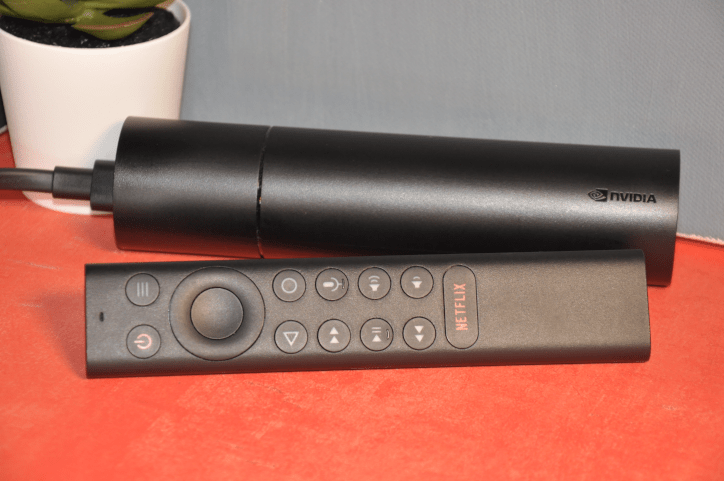
The new smaller Shield is also a great buy for home theater enthusiasts because you’re getting a high-end version of Android TV and have a form factor that’s easier to tuck away — especially if you have a projector hanging from a ceiling.
For everyone else who already owns a NVIDIA Shield, I definitely recommend buying the new remote control which you can easily pair with your older Shield. It will give you a significant upgrade.
NVIDIA Shield TV versus Roku and Fire TV
Roku and Amazon Fire TV have 4K streamers that come as cheap as $30. But the NVIDIA Shield is light-years ahead of them in terms of performance and a customizable interface.
The NVIDIA Shield supports more streaming apps in 4K HDR and Dolby Vision this year. And Dolby Atmos surround sound has been available on the Shield for a while.
So, if wanting the highest picture resolution or sound makes me a geek — so be it.
Menus and Google Play App Selection
Android TV software lets you tap Google Play for a huge library of streaming apps and Android games.
On Shield TV, you can customize the main menu by adding individual channels from streaming services such as Hulu, HBO Max and Disney+.
Philo subscribers can add network-specific channels to the main menu — whether it’s A&E or MTV Live. Adding those channels gives you a feed of popular shows and movies. You can easily get highlights of what’s available to watch without having to dive into each app.
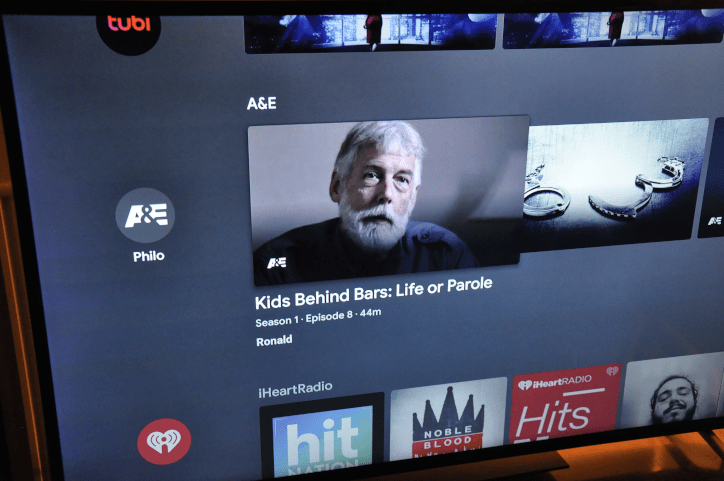
YouTube TV is now starting to offer a similar option for the main menu, but currently, it’s not nearly as polished as what Philo is doing.
Even if Android TV seems a little geeky to you, keep in mind that you’re going to be able to get certain apps such as YouTube Kids, which aren’t available or Roku or Fire TV.
The strength of any Roku or Amazon Fire TV is that it’s a simple plug-and-play streaming device. Your uncle can probably figure out how to hook it up and get it running if you’re not around to help.
It’s a pretty straight-forward vehicle for Netflix, Amazon Prime Video, Hulu or the ESPN app.
The NVIDIA Shield TV is a best 4K streamer isn’t trying to be Roku or a Fire TV device. It’s made for people who want a streamer that can deliver the highest picture resolution and audio on the market.
Dolby Vision on NVIDIA Shield
If you want Dolby Vision on Netflix, Vudu or Disney+, it’s not going to happen on a Roku.
But all those same apps have Dolby Vision and Dolby Atmos support on Nvidia Shield. And that’s one of the bigger differences compared to less expensive, more popular streamers.
The Shield also has a built-in Chromecast Ultra — which is handy if you want to stream some personal photos or 4K videos off your smartphone. A Chromecast Ultra on its own costs about $69.
The power cord connects to one end next to the Gigabit Ethernet port. If you go wireless, the Shield supports 802.11ac Wi-Fi
The HDMI port has HDCP 2.2 and CEC support.
AI Upscaling
The Shield’s AI upscaling technology is its most underrated feature. Even if you are really frugal with streaming subscriptions, AI upscaling brings a significant value proposition all on its own.
There’s an AI demo mode that you can enable by pressing the hamburger style button on the top right of the remote. A slider will pop up on the screen and you can move it back and forth to see the difference in picture quality.
There’s an “enhanced” mode that runs on all video up to 60 frames per second. The “AI-Enhanced” model can upscale HD resolution up to 30 frames per second. Only 4K TV owners can benefit from Shield’s upscaling.
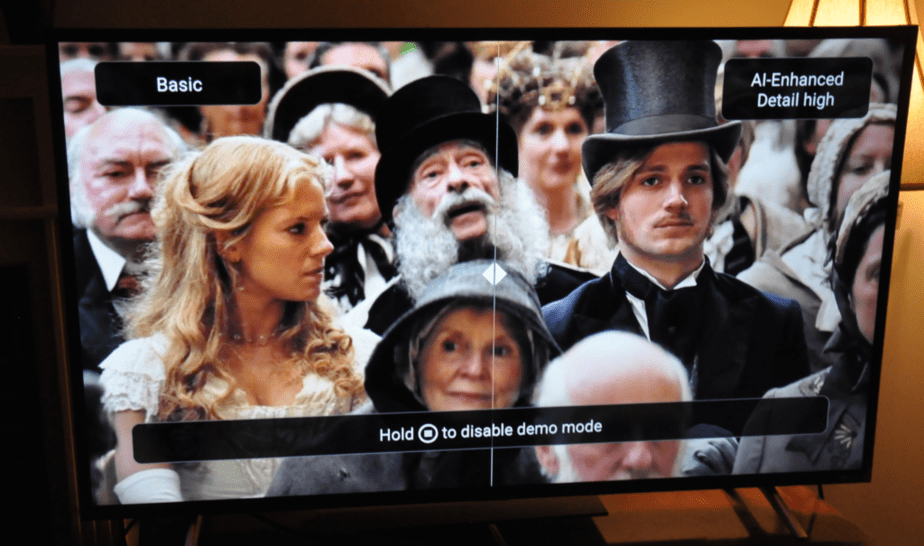
Sure, you can pay extra for 4K HDR on Netflix, Disney+ and Hulu include 4K resolution at no extra charge, but most streaming services only support High Definition picture resolution in 720p or 1080p.
After going app by app through all a number of streaming services, I found that the Shield’s AI upscaling even works on some free, ad-supported streaming platforms such as Pluto TV.
I watched a number of Pluto TV’s on-demand movies and live TV channels using the highest AI setting.
Live TV streaming services were a mixed bag. AI upscaling worked well with most channels on fuboTV, which also offers some programming and live sports in 4K.
If you try to watch one of those same channels on YouTube TV — say a movie on TNT — you’ll get a message saying that the frame rate is not supported for AI enhancement.
The Criterion Channel also got a significant upgrade thanks to the Shield’s AI upscaling. That’s pretty great when you consider that many of the films on The Criterion Channel came out decades ago.
Some film buffs haven’t liked the Shield’s upscaling because they think that it somehow corrupts the original intent of the director. Fair enough.
But if you think about the number of movies that have been remastered since Blu-Ray came out in 2002, nobody has really been complaining about that. To me, upscaling is the next best thing because you might have a favorite old movie that deserves to look a little bit better.
Now you have a choice, and before, you did not.
Google Assistant and new Shield Remote
Having built-in voice control and Google Assistant support is really convenient, especially if you just want to hunt down a 4K video on YouTube.
I really despise using a remote to type something into a search bar. It’s slow. It’s cumbersome. And it really burns time that could be spent watching a movie or TV show.
Shield TV works with Google Home for voice commands, and also supports Amazon Echo if you have one of those kicking around the house.
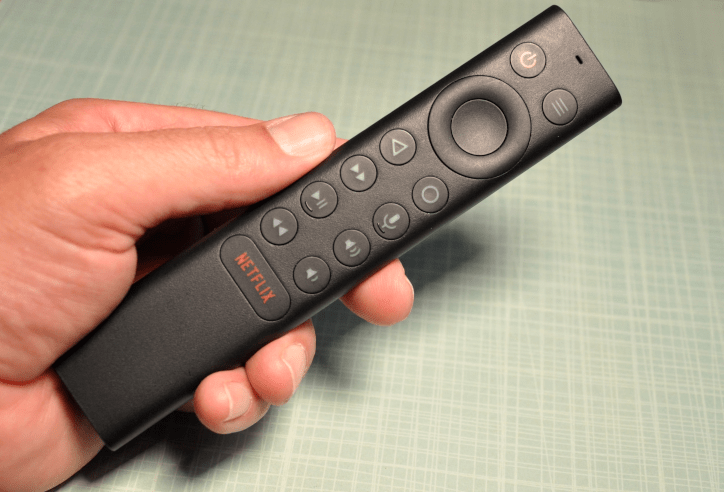
The remotes for Roku and Fire TV devices have improved quite a bit in the last few years, so you can control TV power and volume. That’s really nice.
The new NVIDIA Shield remote has been the first time I ever gave any thought to how a remote feels in my hand. The remote has an odd triangle shape that looks like it shouldn’t be comfortable to hold. It’s actually the exact opposite.
I wouldn’t be surprised if you start seeing copycats of the shape of the Shield’s remote control.
The Shield’s remote has motion-activated backlit buttons. So as soon as the remote moves, it lights up. I watch a lot of TV shows and movies in the dark. That’s really handy if you just want to turn down the volume, or power. There’s no guessing on what you need to press and less distraction while you’re watching TV.
The remote uses two AAA batteries, and there’s a find-my-remote feature, which you can activate under settings using your NVIDIA Shield phone app.
Some other quick facts about the remote
The Shield has CEC support, and that’s a big deal when it comes to the remote control because once you set it up, you will be able to control TV power and volume, or even certain receivers set up in your home theater.
There’s InfraRed and Bluetooth connectivity for audio and video. And battery replacement is super easy with AAA batteries.
Even if you have an older NVIDIA Shield, you can buy the new remote as a replacement to the old one.
The mobile app has many of the same functions as a new remote control, with added keyboard support, launch buttons for apps. There’s also a mouse feature on the mobile app.
Gaming with GeForceNow
Gaming is still pretty useful because I’m more into arcade-style games these days. And I have been happy with streaming my Steam games to my Shield like Mortal Kombat.
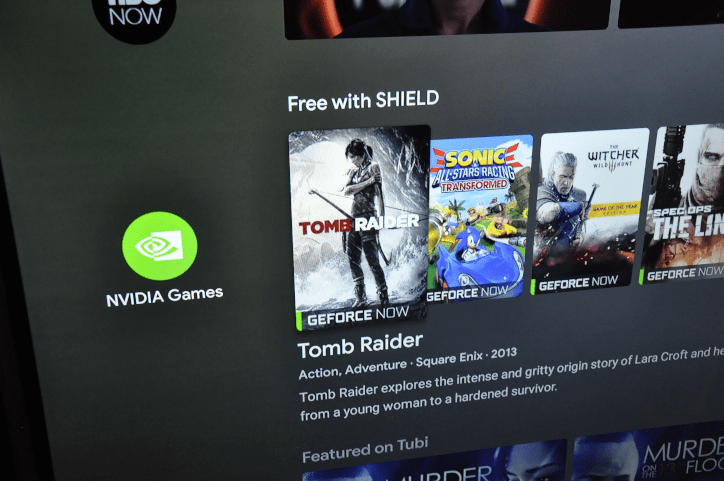
The new NVIDIA Shield doesn’t include a gamepad, but XBox One and PS4 controllers with Bluetooth are compatible.
Whenever I’m reviewing a product or service for my website, I put a lot of weight on its value proposition.
With the new Shield, you’re pretty much getting three core things.
- The fastest 4K streaming device with the high-end Tegra-X1 chip.
- There’s the built-in Chromecast Ulta, which also supports 4K — that’s worth $69 alone — and lets you stream personal photos, videos and streaming apps to your TV.
- A premium remote control with Google Assistant, backlit buttons and the ability to control volume or power. By the way, in the premium remote control market, you can spend $200 to 300 on just a remote and hub alone.
The Shield remote might not be worth $300 bucks, but I can think of a couple models in that price range that has no built-in Google Assistant or back lit buttons.
All software updates to Android TV are known as Shield Experience Upgrades — and those software updates are coming directly from NVIDIA.
And that goes for the remote control as well. There have been 25 software upgrades since 2015. By the way — If you know of another streaming device with that number of software upgrades, let me know about it in the comments below.
Some liner notes on Live OTA TV
With new and older Shield models, it’s pretty easy to add free live TV and DVR features.
I have the 2017 Shield TV PRO, and have it set up as a Plex server so it functions as a DVR for the free over-the-air channels that I get from my TV antenna. I also have my personal movie collection set up on an external hard drive.
TV antennas are gaining popularity as more people discover ways to cut the cord. Most people in the U.S. can get local NBC, CBS, ABC and FOX stations with crisp digital HD reception.
And with ATSC 3.0 coming right around the corner, all that free over-the-air TV will be in 4K.
That’s just going to make the Shield even better.
SiliconDust already announced details of its first ATSC 3.0 TV tuner. Since current HDHomeRun’s support NVIDIA Shield, it’s more likely than not that the NVIDIA Shield will continue to be supported by hardware and software makers like Plex.
For more news on streaming, how-to guides and reviews, head over to the main page of The Cord Cutting Report or follow the CCR on Google News.
Great review! I’m considering purchasing the NVIDIA Shield TV and your review has provided valuable insights into its features and capabilities. Thanks for sharing!